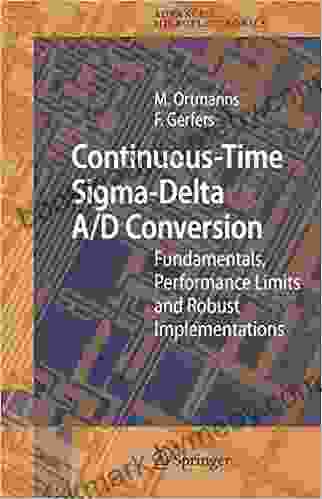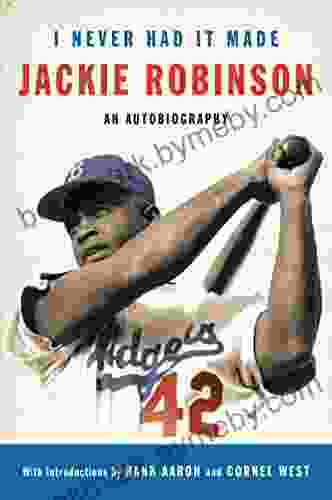Continuous Time Sigma Delta Conversion: The Precision Revolution in Analog-to-Digital Conversion

5 out of 5
| Language | : | English |
| File size | : | 4820 KB |
| Text-to-Speech | : | Enabled |
| Screen Reader | : | Supported |
| Print length | : | 264 pages |
In the realm of electronic systems, analog-to-digital conversion (ADC) serves as a pivotal bridge between the continuous world of analog signals and the discrete realm of digital processing. Continuous Time Sigma Delta Conversion (CTSDC) emerges as a revolutionary technique that elevates ADC performance to unprecedented levels, unlocking a world of precision and accuracy. This comprehensive article delves into the intricacies of CTSDCs, exploring their design principles, implementation strategies, and far-reaching applications, empowering you with the knowledge and insights to harness their transformative potential.
CTSDC: A Paradigm Shift in ADC Technology
Conventional ADCs employ sample-and-hold techniques to capture analog signals at discrete intervals. However, this approach introduces quantization noise and aliasing errors, limiting conversion accuracy. CTSDCs, on the other hand, continuously convert analog signals using a high-speed feedback loop, effectively eliminating these limitations.
At the heart of a CTSDC lies a loop filter that shapes the quantization noise, pushing it out of the frequency band of interest. This noise-shaping technique enhances the signal-to-noise ratio (SNR) and effective resolution, resulting in exceptional conversion accuracy. Moreover, CTSDCs utilize oversampling, further reducing quantization noise and extending the dynamic range.
Key Elements of CTSDC Design
The design of CTSDCs involves careful consideration of several critical elements:
Oversampling Ratio:
The oversampling ratio refers to the ratio between the sampling frequency and the Nyquist frequency. Higher oversampling ratios lead to reduced quantization noise and enhanced SNR.
Noise-Shaping Filter:
The noise-shaping filter is responsible for shaping the quantization noise, ensuring that it is pushed out of the frequency band of interest. Various filter topologies are employed, each offering unique trade-offs in terms of noise shaping and stability.
Quantizer:
The quantizer digitizes the analog input signal, transforming it into a stream of binary digits. Multi-bit quantizers offer higher resolution and accuracy than single-bit quantizers.
Decimation Filter:
The decimation filter reduces the oversampled data rate to the desired output rate, removing out-of-band noise and aliasing artifacts.
Applications of CTSDCs
The exceptional performance of CTSDCs makes them an ideal choice for a wide range of applications, including:
Precision Measurement and Instrumentation:
CTSDCs enable precise measurement of physical parameters such as temperature, pressure, and acceleration, providing superior resolution and accuracy compared to conventional ADCs.
Communication Systems:
In communication systems, CTSDCs are employed for high-speed data conversion, ensuring accurate signal reconstruction and enhancing receiver sensitivity.
Audio Engineering:
CTSDCs offer exceptional audio quality in high-end audio systems, delivering wide dynamic range, low distortion, and accurate reproduction of the analog signal.
Mixed-Signal Design:
CTSDCs are increasingly integrated into mixed-signal designs, combining analog and digital functionality on a single chip, enabling complex signal processing and precision control.
Continuous Time Sigma Delta Conversion stands as a transformative technology in the field of analog-to-digital conversion. Its unparalleled precision, noise reduction capabilities, and wide dynamic range unlock new possibilities in signal processing and mixed-signal design. By embracing CTSDC technology, engineers can push the boundaries of innovation, developing advanced systems that demand the highest levels of performance and accuracy.
Immerse yourself in the world of Continuous Time Sigma Delta Conversion and elevate your understanding of analog-to-digital conversion. Harness its power to unlock precision in your designs and drive innovation to new heights.
5 out of 5
| Language | : | English |
| File size | : | 4820 KB |
| Text-to-Speech | : | Enabled |
| Screen Reader | : | Supported |
| Print length | : | 264 pages |
Do you want to contribute by writing guest posts on this blog?
Please contact us and send us a resume of previous articles that you have written.
 Book
Book Novel
Novel Page
Page Chapter
Chapter Text
Text Story
Story Genre
Genre Reader
Reader Library
Library Paperback
Paperback E-book
E-book Magazine
Magazine Newspaper
Newspaper Paragraph
Paragraph Sentence
Sentence Bookmark
Bookmark Shelf
Shelf Glossary
Glossary Bibliography
Bibliography Foreword
Foreword Preface
Preface Synopsis
Synopsis Annotation
Annotation Footnote
Footnote Manuscript
Manuscript Scroll
Scroll Codex
Codex Tome
Tome Bestseller
Bestseller Classics
Classics Library card
Library card Narrative
Narrative Biography
Biography Autobiography
Autobiography Memoir
Memoir Reference
Reference Encyclopedia
Encyclopedia John M White
John M White Irv Furman
Irv Furman James Duggan
James Duggan Mimi Robinson
Mimi Robinson Jacey Duprie
Jacey Duprie Jalal Al Din Rumi
Jalal Al Din Rumi Jack Vitek
Jack Vitek Tyler Hamilton
Tyler Hamilton J Patrick Boyer
J Patrick Boyer Jack Trout
Jack Trout James D Watson
James D Watson Lynn Morrison
Lynn Morrison Michael Dimercurio
Michael Dimercurio Karen Attman
Karen Attman Jeff Champion
Jeff Champion Jacqueline Melvin
Jacqueline Melvin Jack O Connell
Jack O Connell James F Marran
James F Marran Nick Henck
Nick Henck Shelly Culbertson
Shelly Culbertson
Light bulbAdvertise smarter! Our strategic ad space ensures maximum exposure. Reserve your spot today!

 DeShawn PowellWings of the Reaper: A Literary Masterpiece that Unravels the Threads of...
DeShawn PowellWings of the Reaper: A Literary Masterpiece that Unravels the Threads of... Vincent MitchellFollow ·12.7k
Vincent MitchellFollow ·12.7k Craig BlairFollow ·16.7k
Craig BlairFollow ·16.7k Josh CarterFollow ·14.5k
Josh CarterFollow ·14.5k J.D. SalingerFollow ·18.8k
J.D. SalingerFollow ·18.8k Jonathan FranzenFollow ·7.7k
Jonathan FranzenFollow ·7.7k Bill GrantFollow ·8.3k
Bill GrantFollow ·8.3k Gabriel HayesFollow ·4.7k
Gabriel HayesFollow ·4.7k Joseph ConradFollow ·3.1k
Joseph ConradFollow ·3.1k

 Phil Foster
Phil FosterThe Unforgettable Easter: Ramona's Journey of Discovery...
Embark on Ramona's Extraordinary Easter...

 Levi Powell
Levi PowellThe Old City and Mount of Olives: A Journey Through...
Jerusalem, a city etched into the annals of...

 Henry Hayes
Henry HayesThe Clearances: A Journey Through Scotland's Hidden...
In the 18th and 19th...

 Edward Reed
Edward ReedUnravel the Enigmatic 'Path of Bones' with Cassie Quinn...
Step into the...
5 out of 5
| Language | : | English |
| File size | : | 4820 KB |
| Text-to-Speech | : | Enabled |
| Screen Reader | : | Supported |
| Print length | : | 264 pages |














